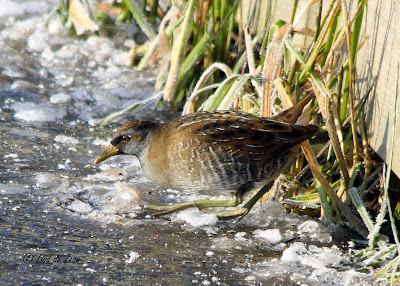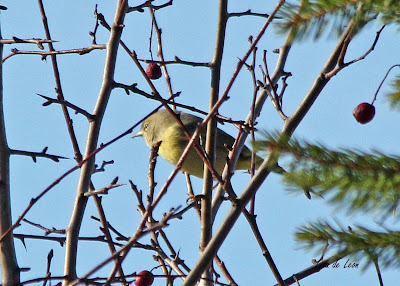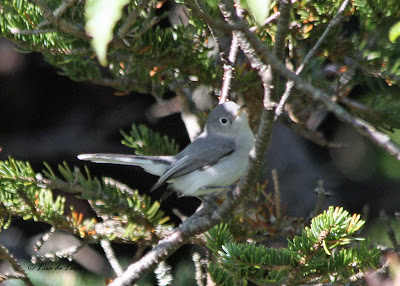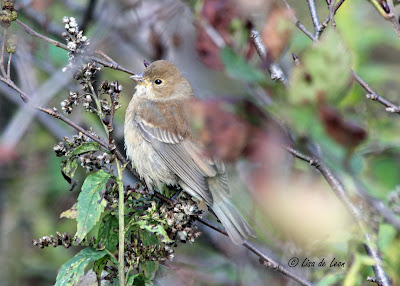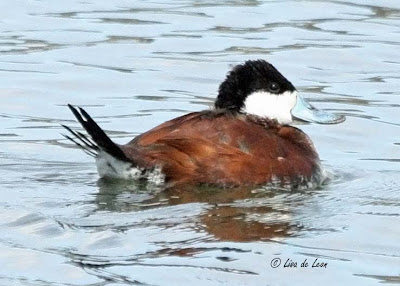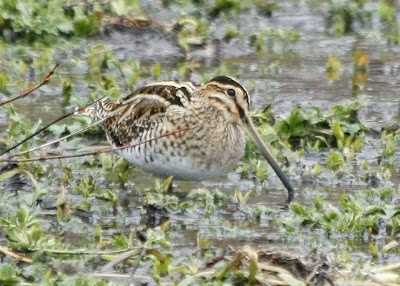I have had an amazing year of birding with a year-end total of 199 species all on the Avalon Peninsula, Newfoundland. There have been spills and thrills and hits and misses, but never a dull day birding. I worked very hard to get this number over 200 but it didn't happen. I made many trips over the year in pursuit of a Yellow-breasted Chat, a Red Knot, Rose-breasted Grosbeak, Ruby-throated Hummingbird, Black Scoter and a Lapland Longspur with no luck. These birds remain on my "yet-to-be-seen" list.
Over the year my pictures have improved, my knowledge has increased and so has the mileage on my car. This photo of the Yellow-bellied Flycatcher (my favorite photo of the year) reminds me of the many quiet moments that I had over the year with a single bird, just the two of us.
The activity in my back yard decreased this year, maybe because of the abundance of cones and berries in the woods since summer. Last year I recorded 29 species in the yard and this year the number dropped to 21. However, I did have some special activity. For the first time a Pine Grosbeak visited my feeder (eating seeds from the ground) regularly for about three weeks. Then there was my first nesting bird. A family of Tree Swallows ruled the yard for a long time as they scoped out the home, then nested and then raised their young here. It was a very interesting process to watch. Most surprising of all the things that I saw was the gathering of so many Tree Swallows on the day that the babies were first born and on the day that they took their first flight. It was like they all attended a baby shower and then a "life launch." There is so much social behaviour among birds and this was a great opportunity to learn first hand about one species.
This image of a Blue-gray Gnatcatcher is a great reminder of one of the longest and most rewarding searches of the year. The area on the East Coast Trail was abuzz with birds on that day but this little one took over three hours to show itself. The thrill of its appearance was remarkable!
Every time I view the pictures of the Hermit Thrush I have a rush of memories of two different occasions (one on La Manche Road and one on Bear Cove Point Road) where we were surrounded by Hermit Thrush. In the Spring these birds were making all kinds of racket and were everywhere. On the second encounter while they were ever so busy and plentiful, they didn't make a sound. Both times there were several other species around.
The traffic to my blog has really increased. In the beginning (February 2010) I had a little over 100 hits a month. Recently, I have had more than 100 hits a day. I can only hope that the content and pictures are helpful and interesting. As a result of my web postings, one of my pictures of a Spotted Sandpiper in flight is being used in a permanent migratory bird display at the Clarence Cannon National Wildlife Refuge in Annada, Missouri. That was quite an unexpected honor.
I was also told that CBC Radio recently quoted my blog on an item about the Red-bellied Woodpecker. That really emphasizes the importance of making my content accurate.
And so another year comes to its end. Last year which was really my first year of birding I was able to see 151 species. This year I have made great progress. At the end of 2010 my Newfoundland Life List stood at 152. As of today I have now seen 220 species. That means that I saw 68 life birds this year! I would never have thought that was possible. There were many days during the year that I didn't see any new birds but was able to better study many birds. Then there were days that I saw as many as three life birds in one day. It left me shaking my head in wonder. What will 2010 bring? Well, I'm sure that I will never match the number that I had this year but I will very likely top up my knowledge of many species. I will be taking on a project for about three months that will surely hamper my ability to go birding this winter. I will post as much as I can and work hard to keep the blog current.
Today, is the last day of the year and the gale force winds have subsided. I will be heading out soon in pursuit of bird number 200 for my yearly list! I will be looking high and low, far and close in an effort to find one more bird! Maybe there will be a King Eider sitting in the water at Cape Spear:) Post Script: I spent a great day looking but was unable to find any new birds today so for me, 2011 stands at 199 species.
Bayfront Park 2022 "Big Year"
1 year ago









